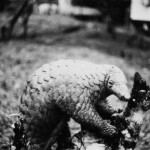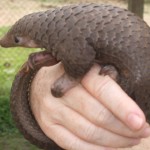Between January and April of this year, media reported on at least fourteen pangolin busts worldwide — and there have already been two others this month.
The events took place across eight countries around the globe and saw the confiscation of an estimated minimum of 600-700 pangolins.
- January: 5
- February: 2
- March: 4
- April: 3
- May: 2 (so far)
Including the two seizures made so far this month (one in Malaysia and one in India), the total may even be as high as 700-800 or more.
Most of these cases involved whole carcasses or live animals, but pangolin scales alone were also seized once in Nepal (seven kilos) and twice in the Philippines (for a total of 102 kg).
The largest known seizure in 2012 took place in Thailand, when 180 of the animals were confiscated from a smuggler in January.
It’s possible that the haul may be outweighed by a March bust in Vietnam that included over 5,000 kg of frozen pangolin and iguana carcasses, but authorities did not detail what percentage of their seizure was comprised of pangolins.
More busts, but less pangolins than in 2011
During the same period last year, media reported on no fewer than six busts that took place around the world.
These included a minimum total of 349 pangolins that were seized in Malaysia, Nepal, and Thailand, as well as an additional 4,726 kilograms of flesh or carcasses confiscated in Africa and 300 kg of the animals’ scales in India.
But experts warn that these busts represent only a small fraction of what’s actually circulating the illegal wildlife trade.
In fact, many suggest authorities only detect about 20% of the wildlife in the black market network -– meaning the total number of pangolins poached in 2011 could be as many as 41,000 to 60,000 individuals.
Chinese authorities seize pangolins from altered vehicle
Last month, Inside China reported that the Qinzhou City Forest Police found 41 dead pangolins and four lives ones stashed under the back seat of a vehicle that had been modified to conceal the illicit haul.
Apparently some arrests were made, but it seems one suspect also absconded after getting a tip off about law enforcement’s plans to apprehend him.
While this is the only pangolin bust media has reported on in China this year, a Chinese national was brought to court in March for illegally smuggling pangolin scales into the country from Angola in 2011.
Pangolin crisis worsens
Demand for the scaly anteaters stems primarily from China and Vietnam, where the flesh of adults and fetuses is considered a delicacy and their scales (and blood and other body parts) are used to make traditional Chinese medicines.
Consumers superstitiously believe these concoctions can reduce swelling, improve liver function, promote weight loss, stimulate blood circulation, enhance lactation in breast-feeding women, and even cure cancer, among other things.
There is no scientific evidence to support any of the medicinal claims made about pangolin body parts.
In fact, both rhino horn and pangolin scales — much like our own hair and nails — are chiefly composed of keratin and studies have repeatedly shown rhino horn to be void of any curative properties.
The already insatiable appetite for pangolins and their body parts is likely being stimulated by lucrative ‘medicinal use’ pangolin farming ventures in China. (Read more about it here.)
Author: Sarah Pappin. Read more about Sarah here.
Image ©Project Pangolin/Saving Rhinos LLC







Comments are closed.